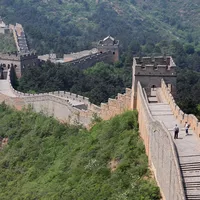127 乐山 大佛
127 Leshan Giant Buddha
127 El Gran Buda de Leshan
乐山 大佛
Leshan Riesenbuddha
Leshan Giant Buddha
在 四川 * 省 西南部 , 有 一条 从北向南 流 的 大河 , 叫 岷江 *。
Im südwestlichen Teil von Sichuan* fließt ein großer Fluss namens Minjiang*, der von Norden nach Süden fließt.
In the southwestern province of Sichuan, there is a large river that flows from north to south, called the Lijiang River*.
传说 * 在 一千二百多年 以前 , 岷江 水流 很 急 , 常常 打翻 * 江 上 的 船只 *, 淹死 * 不少 过河 的 人 。
Legende* Vor mehr als 1200 Jahren war die Strömung des Minjiang-Flusses sehr schnell, sie stürzte oft *Boote* auf dem Fluss und ertrank* viele Menschen, die den Fluss überquerten.
According to legend, over 1,200 years ago, the Lancang River was very turbulent and often overturned the ships on the river*, drowning many people who crossed the river.
当时 有 一个 和尚 *, 想 借神 的 力量 保护 船只 的 安全 , 于是 他 提出 了 在 江边 修 一个 大佛 * 的 建议 。
Damals wollte ein Mönch* die Macht der Götter nutzen, um die Sicherheit des Schiffes zu schützen, und schlug vor, einen großen Buddha* am Fluss zu bauen.
At that time, there was a monk* who wanted to use God's power to protect the safety of the vessel. He then proposed a proposal to build a big Buddha on the riverside.
从那时起 , 很多 石匠 * 整整 花 了 九十年 时间 , 终于 在 江边 的 石壁 * 上修 了 一座 大石 佛 。
Seitdem haben viele Maurer* neunzig Jahre verbracht und schließlich einen großen steinernen Buddha an der Steinmauer* am Fluss gebaut.
Since then, many masons* have spent a total of ninety years and finally built a large stone Buddha on the stone walls* of the riverside.
那 就是 中 国 现在 最大 的 石佛 -- 乐山 * 大佛 。
That is China's largest stone Buddha, the Leshan Giant Buddha.
大佛 身高 七十一 米 , 他 的 头长 十四 米 七 , 眼睛 长三 米 三 。
The Buddha is 71 meters tall. His head is 14 meters long and his eyes are three meters long.
两只 耳朵 长 六米 二 。
Beide Ohren sind 6 Meter lang.
Two ears are six meters long.
他 的 耳朵 里 能 藏 两个 人 !
There are two people in his ears!
人们 在 大佛 的 头颈 * 和 耳朵 后面 修 了 排水 * 通道 *, 所以 不管 下多大 的 雨 , 大佛 也 不会 被 冲走 。
Die Menschen haben Abflusskanäle* hinter Kopf, Nacken* und Ohren des Buddha gebaut, so dass der Buddha nicht weggespült wird, egal wie viel Regen es regnet.
People have built drainage channels* behind the head and neck of the Buddha, so no matter how big the rain, the Buddha will not be washed away.
如果 你 去 中国 , 请 你 去 四川 看 乐山 大佛 , 他会 给 你 带来 好运气 。
Wenn Sie nach China reisen, gehen Sie bitte nach Sichuan, um den Leshan Giant Buddha zu sehen, er wird Ihnen viel Glück bringen.
If you go to China, please go to Sichuan to see Leshan Buddha. He will bring you good luck.
中国に行くなら、四川に行って楽山大仏を見てください。彼はあなたに幸運をもたらすでしょう。

